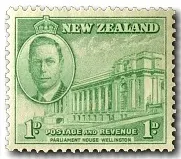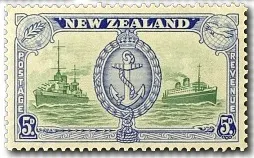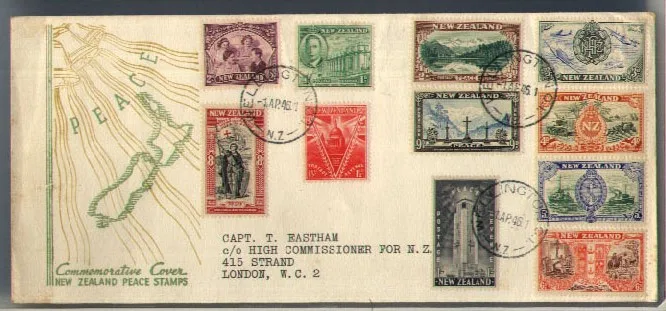I have been interested in the two sets of stamps issued at the end of the first and second World Wars. The first one in 1920 is called the Victory Issue while the second one in 1946 is known as the Peace Issue. Why the difference? This post is going to compare these two issues and try to find why they are so different considering they both mark the end a major war.
1920 Victory
For more see military /ANZAC - Part One.
First, the Victory Issue which marked the end of World War I, a war which was said to have been the war to end all wars. No one would have believed that 20 years later an even bigger war would be raging.

 Green - ½d Red - 1d
Both of these stamps carry a similar theme of the British Lion representing the British Empire, with the allegorical figure of Peace.
Green - ½d Red - 1d
Both of these stamps carry a similar theme of the British Lion representing the British Empire, with the allegorical figure of Peace.
Maori Warrior 1½d - A tribute to the Maori's who served in the War.
This design symbolised 'Progress' as attendant upon 'Peace' - 6d.
The British Lion - 3d King George V - 1/- (1 shilling)
Overprinted on ½d 'Green' - 2d
The Designs.
These designs were prepared by the printing company, Thomas De La Rue, England. The stamps were then printed by the Government Printer, Wellington. Most of the values had themes concerning the British Empire rather than New Zealand themes. Like the title suggests this issue reflected the mood of New Zealand, a celebration of Victory.
The issue was met with condemnation by many stamp collectors in New Zealand. First, there was a lack of New Zealand themes in the issue with only the Maori Warrior 1 1/2d showing anything related to the country issuing the stamps. Secondly, the stamps had been released in London nearly two months earlier by the New Zealand High Commissioner for stamp dealers to sell in England. Some stamps sent by English dealers arrived in New Zealand before they were issued here. It was said this pointed to a greater desire to make money out of the issue than to commemorate the sacrifice so many New Zealanders had made during the war.
Out of these stamps, I think there are 3 that I really like. The British Lion - 3d, The Maori Warrior 1½d and King George V - 1/- (1 shilling).
1/- Colour Trials.
1920 1/- Peace blue colour trial "SPECIMEN" overprint.
1920 1/- Peace brown colour trial SPECIMEN overprint.
Unused Design.
This is a proof from a design that was prepared by Henry W. Barr, a designer with De La Rue & Co, but it was rejected and never used. It shows the Coat of Arms with an insert of King George V. I actually like this stamp better than the ½d that they used because it features something from New Zealand, although it was not our official Coat of Arms.
1946 Peace
For more see Military /ANZAC - Part One.
Following the end of World War II, which had been an even bigger war than the first world war, New Zealand again issued a set of stamps to mark the end of the fighting. I have grouped the stamps below according to by subject rather than by face value.
'Tribute to the People of Britain' - 1½d
This stamp is different to others in this set in that the idea of Victory is included in the design. It almost looks like it could have been included in the 1920 Victory Issue. The view is of St Paul's Cathedral in London with the British flag the 'Union Jack' in the background. The stamp pays tribute to the stand the people of Britain took against the forces of Germany. Although it does not fit with the theme of other stamps in this set I believe it was important to include it.
'Faith in Constitutional Government' - 1d 'In Peace, long may they Reign' - 2d
We then have two stamps which depict aspects of peaceful Government.
In the 1d value, we see the New Zealand houses of parliament with King George VI in the insert.
The 2d shows the Royal Family - His Majesty King George VI, Queen Elizabeth, Princess Elizabeth and Princess Margaret in a frame representing the Royal Crown.
'Tribute to the Air Force' - 3d 'Tribute to the Army' - 4d
The next four stamps show tribute to different groups of people involved in the war effort. In a war such as World War II, all parts of New Zealand society were helping and contributing towards a common goal.
3d - Shows the Badge of the Royal New Zealand Air Force surrounded by some of the aircraft flown by New Zealand pilots. New Zealand airmen in large numbers flew with the RAF during the Battle of Britain. They were also found in many other areas of conflict too.
4d - Shows the New Zealand Army Badge with two scenes where the arm was involved, fighting in the deserts of North Africa and helping on farms to provide food. New Zealand soldiers saw action in North Africa, Italy and in the Pacific against the Japanese.
'Tribute to the Navy and the Mercantile Navy' - 5d
'Tribute to Workers on the Home Front' - 6d
5d - Shows the Navy Badge. In the background on the left is the H.M.N.Z.S. Achilles which took part in the battle of the River Plate where the German pocket battleship Graf Spee was cornered and destroyed. On the right is the Dominion Monarch one of the many ships carrying troops and produce from New Zealand to England.
6d - Shows the New Zealand Coat of Arms. The scenes behind show two of the many tasks performed by people back in New Zealand working in vital industries and on farms. In many cases, these tasks, normally the role of men, were taken over by women.
'The Service and Devotion of Youth in the Nation's Cause' - 8d
'Remembrance' - 1/-.
These two stamps are the memorial stamps to remember the many people who lost their lives during the war.
8d - The stained glass window of the Wellington College Memorial Hall showing a Knight holding a banner depicting the Cross of St George.
1/- (1 shilling) - The National Memorial, Wellington.
'Peace and Tranquillity' - ½d 'A Spirit of Thankfulness' - 9d
Finally, there are two stamps showing the peace which the whole country was looking forward to.
½d - Lake Matheson with the two peaks, Mt Cook and Mt Tasman, in the background. The idea is a beautiful scene in a time of peace.
9d - The Chapel window, Waiho Gorge, with the Franz Joseph Glacier in the background.
The Designs.
The designs for this issue were all prepared by James Berry of Wellington. I believe they include some of his best work. They range through a variety of subjects; Victory, Peaceful Government, Tributes, and Memorials. I believe these stamp reflected the mood of the nation at that time, tired of the conflict of war, ready for peace. The war had gone on for nearly six years and taken a huge toll on such a small country. People were ready to put it behind them and get on with their lives.
First Day Covers.
First Day Cover - 1 April 1946.
1946 illustrated Peace FDC 1-4-1946, by the New Zealand Stamp Dealers Club, incorporates Flag design, single ½d Peace stamp 1-4-1946
Some Printing errors.
1946 ½d Peace, with centre design, moved 1mm upwards to the right.
Above and below show colour shifts centre colour.
An interesting effect caused by a fold in the paper during printing. Note how the frame has been affected while the inside blue seems to have printed correctly. It appears as if the fold was removed for the second colour giving this very unusual effect.
Rudder Retouch on the 3d
Normal. Retouch.
The back of the rudder in the flying boat is normally incomplete but has been strengthened in one impression in each of the two centre plates. This occurs in Row 2/4 in centre plate 42883 and at Row 3/2 in centre plate 42796.
Victory or Peace.
Did you notice the difference between these two sets? There appears to be a totally different way of looking at things in the second set. The first set, The Victory Issue, is a celebration of victory, promoting the British Empire without New Zealand themes. In the second set, The Peace Issue, the themes are mainly New Zealand and the subjects are towards Tribute, Memorial and Peace.
My personal choice.
Out of both sets, I must admit I like the 1946 issue the best. I struggled with captions for the 1920 issue and at one point to considered deleting that part and just making this a post on the Peace Issue. Sure the Victory stamps are good stamps but they just don't compare with the later Peace stamps. The designs in this later set all seem to tell me a story as there is a lot going on in each stamp. I also like the peace theme of many of these stamps too.
1946 Peace Issue - Western Samoa Overprints.
New Zealand postage stamps were often overprinted for use in other South Pacific countries such as Niue, the Cook Islands and Western Samoa, as shown here. Due to the population of Germans living in Western Samoa, it was decided to make these stamp only available if asked for.
'Faith in Constitutional Government' - 1d 'In Peace, long may they Reign' - 2d
'Tribute to Workers on the Home Front' - 6d
'The Service and Devotion of Youth in the Nation's Cause' - 8d
1920 Victory - Technical information.
Date of issue: 27 January 1920.
Designers: Thomas De La Rue, England.
Printers: Government Printing Office, New Zealand.
Stamp size: ½d, 2d, 3d and 1s : 36mm x 24.5mm; 1d : 24.5mm x 30mm; 1½d : 30mm x 24.5mm; 6d : 24.5mm x 36mm.
Sheet size: ½d, 2d, 3d, 6d and 1/-: 140 stamps per sheet; 1d and 1½d: 160 stamps per sheet.
Process: Surface printed - Typography.
Perforation gauge: 14.
Paper type: De La Rue, chalk surfaced, NZ and star watermark.
1946 Peace - Technical information.
Date of issue: 1 April 1946.
Designers: J Berry, Wellington.
Printer: Harrison and Sons, England; Bradbury Wilkinson, England and Waterlow and Sons, England.
Stamp size: ½d, 3d, 4d, 5d, 6d and 9d : 40mm x 24mm; 1d and 2d : 29mm x 24mm; 1½d : 24mm x 29mm; 8d and 1s : 24mm x 40mm.
Sheet size: ½d, 3d, 4d, 5d, 6d, 8d, 9d and 1s: 120 stamps per sheet; 1½d: 160 per sheet; 1d and 2d: 240 stamps per sheet.
Process: Recess printed - Intaglio and Photogravure.
Perforation gauge: 1½d and 1/- : 14 x 15; 1d and 2d : 13.5 x 13; ½d, 3d, 4d, 5d, 6d, 8d and 9d : 13.5.
Paper type: Wiggins Teape 'Royal Cypher', multiple NZ and star watermark.
Some of the images in this post were used with permission from the illustrated catalogue of StampsNZ
Information & images for this post came from.

































Allan you bring out a contrast I never noticed before. I've always considered both these sets to be victory sets after each war but there is a difference. You can clearly see the strong theme of 'Victory' in one and the theme of 'Peace" in the other.
ReplyDeleteAnother point you could bring out is the difference between the subjects of each set, While the 1920 Victory set is focused England and the Empire, the 1946 Peace set has more of a focus on New Zealand. I believe this is a sign of the country drifting way from the 'Mother Country' to become a more independent nation.
BC
Where can I go If I wish to sell some stamps I collected as a child
ReplyDeleteI have several of the stamps above and want to pass them on to someone. Where can I go?
ReplyDeleteWe are not stamp dealers so our advice is strictly one collector to another.
Deleteyou could try a dealer like the one whose name appears at the bottom of all our post. It depends where you live in the world. Or you could try E-bay of Trade-me. Get an idea on prices first of course.
Asami on behalf of Allan.